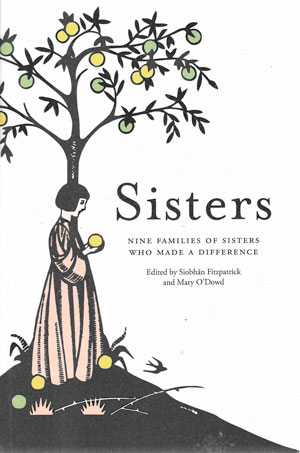SISTERS: NINE FAMILIES OF SISTERS WHO MADE A DIFFERENCE
Published in Book Reviews, Book Reviews, Issue 6 (November/December 2022), Reviews, Volume 30SIOBHÁN FITZPATRICK and MARY O’DOWD (eds)
Royal Irish Academy
€25
ISBN 9781911479833
Reviewed by Mary Kenny
Mary Kenny is the author of The way we were: Catholic Ireland since 1922 (Columba Books, 2022).
It used to be a feminist principle that the family was the source of women’s oppression. The home was a prison, marriage was bondage, and motherhood, as de Beauvoir insisted, made women a ‘slave to the species’.
Now, however, I notice a revised version of the family emerging. Perhaps the rough patriarchal edges of the institution have been erased—consider all those TV comedies in which fathers are portrayed as idiots—and we are more inclined to view family life as benign. Or perhaps it was always thus—that women are the heart of the family, often bind it together, and may develop empowerment through the solidarity of a family network.
In the most modern group portrayed in this impressive collection of Irish sisters (from the 1600s to the 1900s), the Sheehys, we see the diversity, strength and contrasting narratives of four remarkable sisters: Hanna, Margaret, Mary and Kathleen, described by Margaret Ward, who has a peerless grasp of her subject. Hanna married the radical feminist and atheist Sheehy-Skeffington. Margaret married, en première noce, Frank Culhane, and subsequently—widowed, aged 42 and the mother of four—ran off with her godson, Michael Casey. Mary married Tom Kettle, the brilliant young parliamentarian who died in the First World War, and Kathleen wed Francis Cruise O’Brien, becoming the mother of Conor. They grew up in a gregarious and hospitable household in Dublin (James Joyce was a visitor), and often had quite divergent views on politics and religion; yet the affection and solidarity held together. This is riveting social history—well suited to a family saga in the form of an epic novel.
Similarly with the close relationship between Constance and Eva Gore-Booth: Eva was a gay pacifist who lived in happy partnership with socialist Esther Roper, while Constance, as we know, took a position of leadership in the 1913 Lockout and the 1916 Rising. Sonja Tiernan brings a psychological analysis to the way in which both rejected their landed background. Constance and Eva were both motivated by compassion for the poor—but in Con’s case there was also an element of seeking the excitement of rebellion. There was an unbreakable tenderness between the sisters, although one aspect of their connection is overlooked: both had a religious cast of mind and understood each other’s sensibilities with an almost mystical bond.
The Yeats sisters, Lily and Elizabeth, weren’t always charitable towards the Gore-Booths: Lucy Collins quotes Lily’s malicious quip that ‘Madame Markievicz’s madness changed from when she inherited it’—their father having been a somewhat reckless North Pole adventurer. It can’t have been easy being sisters to W.B. and Jack Yeats, and their lovely Cuala Press was an economic struggle. Yet their artwork was exquisite.
The Parnell sisters, Anna and Fanny, had an even more difficult time in the shadow of their brother, Charles. Diane Urquhart brings to life their valiant, but ultimately suppressed, endeavours to establish the Ladies’ Land League against Victorian prejudices about women venturing outside of the domestic sphere. If there is a patriarchal oppressor in this scenario it is C.S.P. himself, supported by his wife Katharine, who regarded her sister-in-law Anna as ‘a fanatic spirit’, ‘extreme’ and ‘abnormal’. Anna Parnell was sometimes unwise in her utterances—berating Gladstone, who was Ireland’s best chance, was injudicious. Yet Fanny’s poetry advanced peaceful means of change, and both sisters were pioneers in women’s entitlement to claim their place in political action.
Nualaidh, Máire and Mairghéad, daughters of Aodh Ó Domhnaill and An Inghean Dubh—died in the 1620s, buried in Louvain—are chronicled by Padraic Ó Macháin and provide a glimpse into the lost world of the old Irish chieftains who fled to the Continent. Their stories emerge in bardic poetry, in Irish (and translated). The Boyles of Cork, by Ann-Maria Walsh, and the Conyhams of Castletown, by Gaye Ashford, illuminate the matriarchal power which could be available to women in larger families—as well as the hazards of childbirth and infant mortality.
Quaker women, as exemplified by the Shakleton sisters in an arresting essay by Mary O’Dowd, had more opportunities for equality and freedom than most eighteenth-century females: they could preach, could be appointed as clerks in meeting-houses and often travelled around quite freely. The downside was a somewhat austere mode of dress, a disapproval of frivolities and no music or arts. The Shakleton sisters nevertheless emerge as lively young girls. (Incidentally, daughters of the same father by two marriages are half-sisters, not stepsisters.)
Lady Sydney Morgan was the author of the ground-breaking The wild Irish girl and the subject of many portraits in oil, attractively reproduced here. She and her sister Olivia were the daughters of actor-manager Robert Owenson and often toured with him, risking ‘the stigma of the stage’ in rackety set-ups. But the life was a stimulus to their romantic imaginations. They also had some education at the Huguenot school in Clontarf, which was French-speaking. Claire Connolly considers Sydney to be a pioneer of modern feminist independent action, writing poetry, travel books and biographies, as well as a tract on the subjugation of women, ‘Woman and her Master’, in 1840. And her marriage to Sir Charles Morgan was a long and happy one, without, apparently, a scintilla of patriarchal oppression!

















